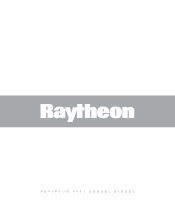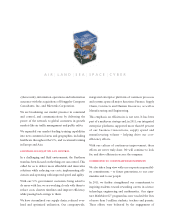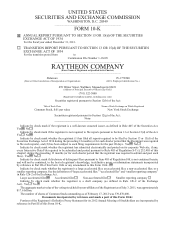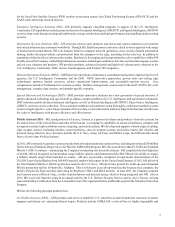Raytheon 2011 Annual Report Download - page 10
Download and view the complete annual report
Please find page 10 of the 2011 Raytheon annual report below. You can navigate through the pages in the report by either clicking on the pages listed below, or by using the keyword search tool below to find specific information within the annual report.2
Arabia, Kuwait, Taiwan, Greece, Spain, South Korea and UAE. The National Advanced Surface-to-Air Missile System
(NASAMS), also offered by IAMD, is a highly adaptable mid-range solution for any operational air defense requirement, and
is deployed in the U.S. National Capital Region, Norway, Spain, and the Netherlands. Additionally, IAMD provides the Hawk
XXI, an advanced air defense system against low- to medium-altitude air threats, with advanced fire control and battle
management.
Global Integrated Sensors (GIS)—GIS provides integrated whole-life air and missile defense systems for the U.S. Army,
Navy, Air Force, MDA, and international partners. These systems enable warfighters to detect, track and engage threats
through air and ground-based sensors and command and control systems, as well as provide joint system solutions and
intelligence support for air and ballistic missile defense. GIS produces systems and solutions, such as the Joint Land Attack
Cruise Missile Defense Elevated Netted Sensor (JLENS), which is a theater-based, advanced sensor system that provides
long-endurance, over-the-horizon detection and tracking capabilities required to defeat hostile cruise missiles. GIS also
produces Early Warning Radars, including the X-band Family of Radars, such as the AN/TPY-2, the world's most advanced
mobile X-band radar, and the Sea-based X-band (SBX) radar, which provide threat detection, precision tracking, discrimination
and classification of ballistic missile threats. GIS also offers integrated capabilities for persistent surveillance, multi-domain
awareness, decision-making, information fusion and space situational awareness through a broad range of solutions.
Seapower Capability Systems (SCS)—SCS is a provider and integrator of submarine and surface ship combat management,
airborne anti-submarine and mine warfare, and integrated ship systems, as well as sensors, maritime naval navigation systems
and torpedoes for U.S. and international navies. SCS is a leader in the U.S. Navy's Open Architecture initiatives for surface
combatants, serving as the prime contractor of mission systems for the Navy's DDG 1000 combat system and providing the
Ship Self Defense System, an open, distributed combat management system for U.S. Navy carriers and amphibious ships. For
the DDG 1000 program, SCS designs and produces the software and hardware for the mission systems equipment, which
includes the Total Ship Computing Environment, radar, sonar, and the associated electronics systems. SCS also offers a range
of navigation and integrated bridge systems for military and commercial markets worldwide. In addition, SCS is developing
and supporting several large dual-frequency naval radar programs, including the U.S. Navy's Dual Band Radar, the primary
sensor for CVN 78 Ford-class carriers, and Cobra Judy Replacement, a program for which Raytheon is the prime contractor.
IDS is also currently developing a technology demonstrator for the Air and Missile Defense Radar program (AMDR), a
scalable and technologically advanced radar system which is expected to provide the U.S. Navy with significantly increased
detection range and powerful discrimination accuracy.
Intelligence and Information Systems (IIS)—IIS, headquartered in Garland, Texas, is a leader in intelligence, surveillance
and reconnaissance (ISR), advanced cyber solutions, and U.S. Department of Defense (DoD) space, weather and environmental
solutions. Approximately half of its business is for classified customers. Key customers include the U.S. Intelligence
Community, DoD agencies, the National Oceanic and Atmospheric Administration, the Department of Homeland Security,
the Federal Bureau of Investigation and the National Aeronautics and Space Administration (NASA).
In 2011, IIS was awarded a number of classified contracts, and recorded major bookings on the Joint Polar Satellite System
(JPSS), the latest generation of U.S. polar-orbiting, non-geosynchronous, environmental satellites. Also in 2011, the Company
acquired Pikewerks Corporation, a privately-held company headquartered in the Huntsville, Alabama area, bolstering IIS'
end-to-end cyber capabilities by adding deep expertise and products in the areas of insider threat protection, software protection
and forensics. The Company also acquired Henggeler Computer Consultants, Inc., a privately-held company headquartered
in Columbia, Maryland, further extending IIS' capabilities to serve the cybersecurity, enterprise architecture and systems
engineering needs of customers in the Intelligence Community as well as in the DoD. In 2011, IIS was negatively impacted
by the drawdown on U.K. Border Agency (UKBA) Program letters of credit by the UKBA as described under “Commitments
and Contingencies” on page 68.
IIS has the following principal product lines:
Defense and Civil Mission Solutions (DCMS)—DCMS provides multi-INT ground systems, unmanned systems technology,
environmental information management systems and satellite command and control. Additionally, DCMS provides large-
scale information processing, information integration and visualization systems for intelligence, satellite and space-based
programs for commercial and DoD customers. Key programs include advanced ground solutions for strategic and tactical ISR
missions, including Global Hawk, U-2, and the U.S. Air Force's Distributed Common Ground System (DCGS), a network-
centric system for the U.S. armed forces designed to enable real-time information sharing. DCMS also provides ground stations























